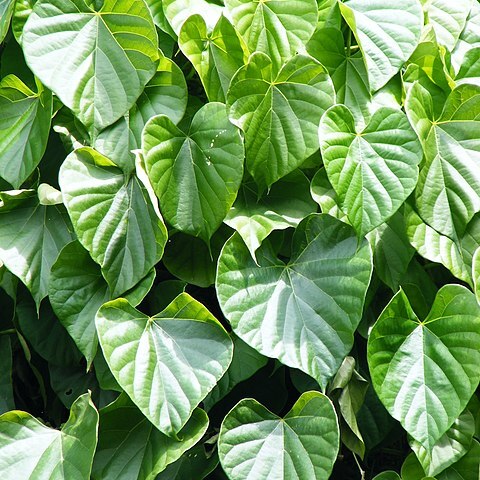Vines, often with conspicuous aerial roots. Leaf blade not peltate, base cordate, sometimes sagittate or hastate, palmately veined. Inflorescences axillary or on old leafless stems, solitary or fascicled, racemose, cymose, or paniculate. Male flowers: sepals usually 6 in 2 whorls, free, imbricate, outer 3 usually conspicuously smaller, membranous; petals (3 or)6, base clawed, often with lateral edges involute; stamens 6, filaments free [or connate], anthers subextrorse, dehiscing longitudinally and obliquely. Female flowers: sepals and petals as in male except petals often smaller; staminodes 6; carpels 3, curved-ellipsoidal, style short, fat and thick, stigma reflexed with short, pointed lobes. Drupes 1-3 borne on a short or columnar carpophore, style scar subterminal; endocarp bony, horseshoe-shaped, abaxially convex and sometimes verrucose or tuberculate, adaxially ± flat; condyle broad, with central aperture leading to a globose cavity. Seed half-moon-shaped; endosperm ruminate; cotyledons foliaceous, ovate, extremely thin, much longer than radicle.
Herbaceous or woody lianes, sometimes small, rambling shrubs. Leaves simple, entire; nerves palmate, rarely pinnate. Male inflorescences of false racemes, which are either simple or compound (i.e. panicles), of 2–4-flowered cymules. Male flowers with 6 sepals, the 3 inner much larger than the outer, hyaline or membranous; petals 6, rarely 3, fleshy, with inrolled margins, the inner smaller than the outer; stamens 3–6, quite free, or with their filaments connate either at base, half-way up or for their entire length; antherthecae with longitudinal dehiscence. Female inflorescences of false racemes of solitary flowers. Female flowers with sepals and petals similar to those of the ♂; carpels 3, obliquely ovoid. Drupes 3 or fewer; exocarp pulpy; endocarp ± verrucose outside, with a condyle on its inner side which makes a large subglobular cavity. Seeds with fleshy ruminate endosperm.
Woody climbers, without prickles. Leaves very variable in Australian species, palmately veined at base, veins not extending to leaf margin. Inflorescences often racemose, axillary or sometimes on leafless plants, glabrous or puberulous, without accrescent bracts. Male flowers: sepals usually 6 in 2 whorls, the inner usually larger, imbricate, sometimes a third reduced outer whorl present; petals usually 6, free (in Australia); stamens 6, free (in Australia). Female flowers: staminodes 6; carpels 3; stigma reflexed. Drupes of various shapes, borne on carpophore; style-scar terminal; endocarp bony, dorsally convex and variously ornamented (in Australia), with a ventral aperture. Seed dorsiventrally flattened and concave; endosperm present, usually ruminate; cotyledons thin, foliaceous.
Male flowers with 6 sepals, the 3 inner much larger than the outer, hyaline or membranous; petals 6, rarely 3, fleshy, with inrolled margins, the inner smaller than the outer; stamens 3–6, quite free, or with their filaments connate either at the base, half-way up, or for their entire length; anther-thecae with longitudinal dehiscence.
Drupelets 3 or fewer; exocarp pulpy; endocarp more or less verrucose outside, with a condyle on its inner side which makes a large sub-globular cavity.
Male inflorescences of false racemes, which are either simple or compound (i.e. panicles) of 2–4-flowered cymules.
Female flowers with sepals and petals similar to those of the male; carpels 3, obliquely ovoid.
Herbaceous twiners or woody lianes or sometimes small, rambling shrubs.
Female inflorescences of false racemes of solitary flowers.
Leaves simple, entire; nerves palmate, rarely pinnate.
Seeds with fleshy ruminate endosperm.

